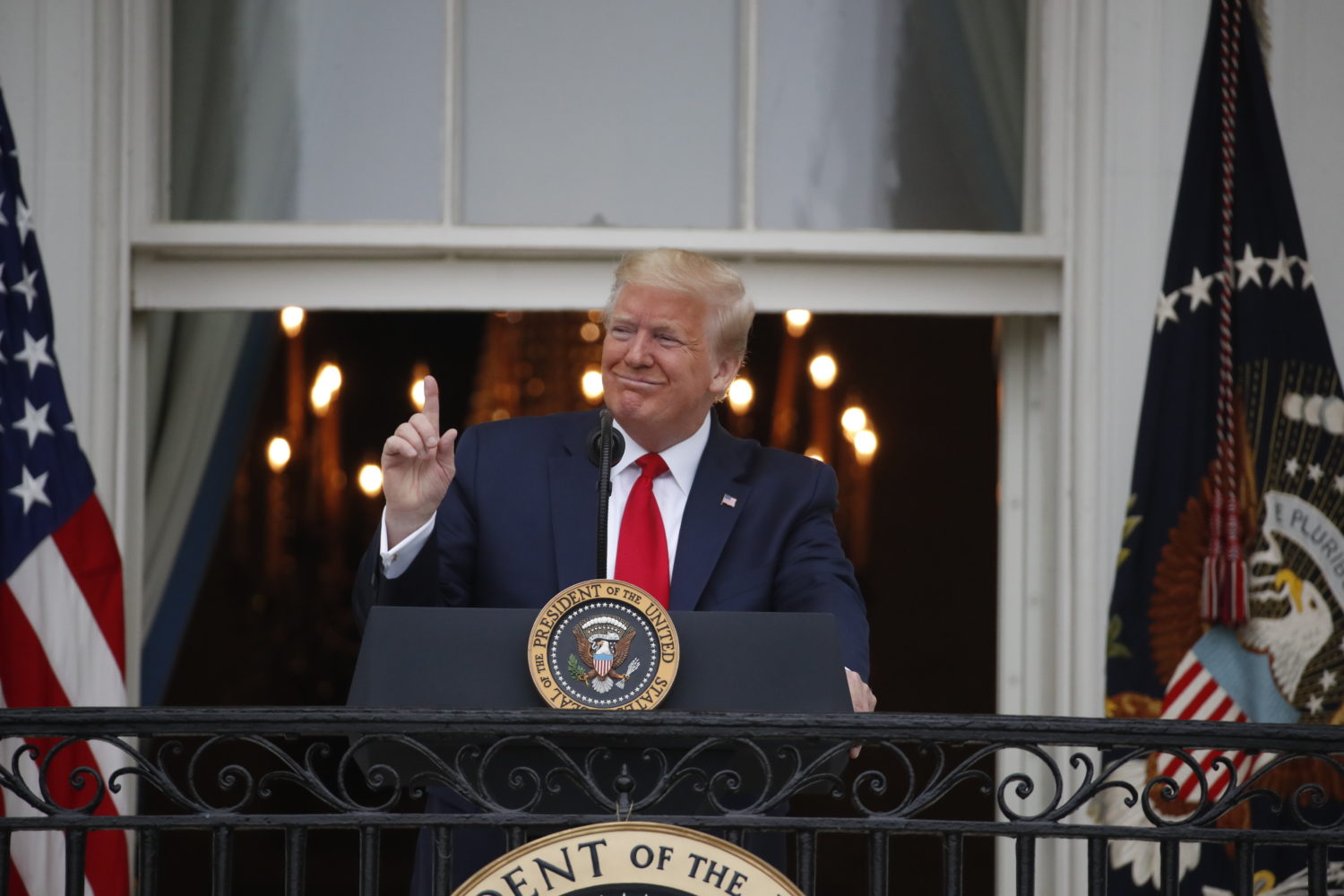Factually is a newsletter about fact-checking and accountability journalism, from Poynter’s International Fact-Checking Network & the American Press Institute’s Accountability Project. Sign up here.
Why Twitter’s ‘get the facts’ label matters
For the first time, Twitter this week flagged two tweets from the president of the United States. It didn’t choose the tweets that had attracted the most attention in Tuesday morning’s barrage from the White House (those would be the ones about Joe Scarborough). Nor was Twitter’s label particularly bold.
“Get the facts about mail-in ballots,” read the blue label underneath President Donald Trump’s tweet that mail-in ballots used in November’s election will be “substantially fraudulent.”
Some saw the label as a bit subtle, noting that unless you clicked on it, the message could be seen as a warning about mail-in ballots, not about Trump’s tweet. It was widely called a fact-check, but was really just a flag that linked to a collection of tweets with links to news stories and other information about mail-in voting. One question is whether the label would change anyone’s thinking on the issue. Trump loyalists might just dismiss Twitter’s warning as “fake news” and move on.
But it was a flag, nonetheless – a big step for Twitter after years of pressure from its critics to take action against Trump and his falsehoods on his social media platform of choice.
[the_ad id=”667826″] [the_ad id=”667872″] [the_ad id=”667878″]
So what happens next?
First, now that Twitter has applied the label for the first time to Trump, we can expect ongoing fights over who gets checked and who doesn’t. Some conservatives already claim, without evidence, that they face “censorship” on social media platforms. Trump on Wednesday threatened (on Twitter, of course) to “strongly regulate” the companies “or shut them down.” On Wednesday White House reporters tweeted that Trump’s press secretary said he would soon sign an executive order “pertaining to social media” but did not provide details.
The notion that the social media platforms have a liberal agenda has been a running theme in conservative circles, one echoed Tuesday by Trump’s 2020 campaign manager, Brad Parscale. “Partnering with the biased fake news media ‘fact checkers’ is only a smoke screen Twitter is using to try to lend their obvious political tactics some false credibility,” he said. In fact, Twitter cited fact-checks in the links it provided, but has not officially “partnered” with fact-checkers the way Facebook has. And in any case, Facebook generally does not subject politicians’ posts to fact-checking. Notably, the same statement went unflagged on Facebook as recently as late Wednesday. =
The other – perhaps more consequential – meaning of the label is that it suggests Twitter is taking seriously Trump’s efforts to undercut mail-in voting as a growing number of states are turning to it in light of the coronavirus pandemic.
Trump has in recent months weaponized the issue, as The New York Times put it this week, despite the fact that states widely using mail-in voting have not seen an increase in election fraud. The narrative that mail-in voting is more subject to manipulation than in-person balloting is not supported by election experts, even those who acknowledge that it’s not perfect. There are scores of fact-checks and analyses of the issue. Some experts have suggested Trump’s real agenda is to lay the groundwork for disputing the November results.
In other words, Twitter picked for its first fight one where it had plenty of ammunition – and where the stakes couldn’t be higher.
– Susan Benkelman, API
. . . technology
- Hackers have launched cyber-attacks on the computers of British people working from home as a result of the coronavirus lockdown, the Guardian reported. The attacks include malicious email campaigns, fake requests to reset their virtual private networks, and an increase in spoofing attacks, the paper said.
- “One spoofing attack featured an unnamed company chief executive supposedly asking workers to donate to his health charity, while others mimic IT support departments asking workers to download new software,” wrote Jasper Jolly.
- The MIT Technology Review’s Abby Ohlheiser reviewed a new analysis on why older Americans are more likely to share false information on social media. Fact-checks aren’t necessarily the solution, she writes.
. . . politics
- The American Civil Liberties Union has filed a lawsuit on behalf of two journalists challenging two Puerto Rico laws that make it a crime to share information about “fake news.” Violators face up to three years in jail and a fine of up to $5,000.
- Axios cited the lawsuit in a story about the proliferation of such laws around the world. “Targeting the press under the guise of stopping ‘fake news’ is increasingly becoming more normalized,” wrote Sara Fischer.
- The new chairman of the U.S. Senate Intelligence Committee, Marco Rubio, warned in an interview with the Associated Press that foreign actors will amplify conspiracy theories about the coronavirus and find new ways to interfere in the 2020 presidential election.
- “I think the COVID-19 crisis is one in which you’ve seen efforts to promote false narratives that drive some of the friction in this country,” the Florida Republican said.
. . . science and health
- The BBC took a deep dive into the human costs of misinformation and conspiracy theories, including people who consumed detergent and some who didn’t believe that COVID-19 was a real illness, so didn’t take their symptoms seriously at first.
- “We thought the government was using it to distract us, or it was to do with 5G. So we didn’t follow the rules or seek help sooner,” Brian Lee Hitchens told the network from his hospital bed in Florida, where his wife was critically ill and on a ventilator in an adjacent ward.
- The COVID-19 pandemic is an “experimental subject like no other” for people who study health and science disinformation, Philip Ball and Amy Maxmen wrote for Nature this week.
- “This is an opportunity to see how the whole world pays attention to a topic,” Renée DiResta at the Stanford Internet Observatory in California told the authors.
[the_ad id=”667826″] [the_ad id=”667872″] [the_ad id=”667878″]
This week’s fact-check deals with a claim that is popular in the CoronavirusFacts Alliance database — that Italian doctors discovered COVID-19 was a bacterial disease and had found a cure.
This claim first appeared in Mexico, but has since spread to India where fact-checking network FactCrescendo broke it into three parts and addressed each separately.
First, the fact-check cited the broad scientific consensus that COVID-19 is a virus, not a bacterial disease. Second, it quoted health experts in India and Italy to debunk the idea that ventilators won’t help COVID-19 patients. Third, it addressed the nuance that while some COVID-19 patients have died from inflammation of the blood vessels, the overwhelming evidence shows this is not the primary cause of death.
What we liked: This fact-check was easily digestible, but more importantly, it highlights how a claim like this can spread from country to country. FactCrescendo used a combination of local and international experts to explain why this claim is incorrect, and hopefully, stop its spread.
– Harrison Mantas, IFCN
[the_ad id=”667826″] [the_ad id=”667872″] [the_ad id=”667878″]

- Researchers from the University of Wisconsin reported this week that the effectiveness of fact-checks depends on what people knew about an issue before encountering the fact-check and whether the story is clearly labeled as one.
- A study out of France’s Université Science Po finds there was a 25% decrease in the sharing of misinformation after study participants were exposed to fact-checks.
- Brazil’s federal police searched the homes and offices of allies of President Jair Bolsonaro on Wednesday, Reuters reported, as part of an investigation into alleged “fake news” attacks against the country’s Supreme Court.
- The Guardian reported that Australian mobile phone companies are working with police to head off more arson attempts at 5G cellular towers. The fires are based on a conspiracy linking the technology to COVID-19.
- PolitiFact’s Daniel Funke wrote about ways to fact-check your friends and family about COVID-19 misinformation.
That’s it for this week! Feel free to send feedback and suggestions to factually@poynter.org. And if this newsletter was forwarded to you, or if you’re reading it on the web, you can subscribe here. Thanks for reading.









